tooth resorption cats prognosis
Tooth resorption is when the dentin the hard tissue beneath a tooths enamel of a single tooth or multiple teeth erodes left untreated it can cause irreparable damage. 3 Dental radiographs are required for proper diagnosis and treatmentFeline tooth resorption TR a common disease in cats characterized.

External Cervical Resorption A Review Of Pathogenesis And Potential Predisposing Factors International Journal Of Oral Science
Tooth resorption in cats unfortunately often goes undiagnosed.

. Cavities are caused by bacteria that create acid. Ad Ensure Your Pet Is Happy And Healthy And Enjoy Savings On Pet Medications. In this guide let us take a closer look at.
Tooth resorption also called feline odontoclastic resorptive lesion is when the tooth starts breaking from the inside. Oral disease in cats comprises four major conditions. Full mouth veterinary dental radiographs are needed for both diagnosis and treatment.
Tooth resorption is a process by which the dentin a hard tissue that lies. The decay begins at the base near the root and spreads to the entire tooth. Tooth resorption is a medical condition where a cats tooth begins to break down and be absorbed by the body.
12 Risk factors include increasing age and the presence of other dental disease including additional TR lesions. Tooth resorption in cats unfortunately often goes undiagnosed. Eventually the entire tooth right down to the pulp will be destroyed.
Tooth Resorption vs. However subtle indications include a tendency to gobble up their food quickly as eating causes pain or only eating on one side of their mouth. Periodontal disease oral neoplasia particularly squamous cell carcinoma feline stomatitis and tooth.
Incidence reports list a range from 30 to 60 for cats affected by this oral condition. Diagnosing Tooth Resorption in Cats. All types of teeth in the feline dentition may be affected but lesions seem to be more common in certain teeth.
Get the pawfect insurance plan for your pup. From 522 quotes ranging from 500 - 1000. Brett Beckman on September 06 2016.
Tooth Resorption Average Cost. Find details on Odontoclastic tooth resorption resorptive lesions in cats including diagnosis and symptoms pathogenesis prevention treatment prognosis and more. Brett Beckman on May 12 2021.
Oral disease in cats comprises four major conditions. Feline Tooth Resorption. Full mouth veterinary dental radiographs are needed for both diagnosis and treatment.
The most common dental disease in domestic cats is a destructive process called tooth resorption. Also referred to as replacement resorption if your cat is diagnosed with Type 2 Tooth Resorption the tooth root will look like it is disintegrating making it hard to differentiate from the bone on the radiograph. Cats develop tooth resorption when their bodies begin breaking down.
Symptoms of tooth resorption. Tooth resorption is seen as a pinkish defect where the tooth meets. Tooth resorption affects at least one tooth in 20 to 60 of all cats.
Tooth enamel will then begin to flake off. Symptoms of tooth resorption in cats. Though the cause of this condition is unknown there are some treatment options available to save the felines from the pain and discomfort involved.
This painful condition is believed to affect more than 65 of cats during their lifetime. Schwalder P Stich H et al 1998 Differential diagnosis of resorptive dental lesions FORL and caries. Symptoms of Tooth Resorption in Cats.
Trusted Care For Yout Pet - Rely On Our Expert Pharmacists Free Ask The Vet Service. Vet bills can sneak up on you. This process usually starts in the enamel of the tooth but it can eventually affect every part of the tooth.
If your cat is showing any symptoms as described above your vet may also recommend blood tests urinalysis sedation and dental x-rays. Periodontal disease oral neoplasia particularly squamous cell carcinoma feline stomatitis and. Your cat may also start to prefer wet food over dry kibble and the wet.
This acid breaks down the enamel and dentin of the tooth which can kill the tooth. This can lead to pain and complications that require dental surgery to fix. Cats are masters at hiding pain so it can be tricky to know if theyre having dental troubles.
Other sources of information. The cause of tooth resorption is currently unknown but the condition seems to develop when a cell within the tooth called an odontoclast is activated and. Cats are stoic creatures naturally inclined to hide signs of pain.
A thorough physical exam by your vet along with sedation to further evaluate the mouth gums and teeth using dental x-rays is the best way to diagnose TR in cats. More than 70 of cats over five years of age show signs of tooth resorption. Feline tooth resorption may show no visible signs other than gingivitis gum inflammation in its early stages although you may also notice signs of blood in your cats water or food bowl.
Three-quarters of these cats are ages 5 or older but tooth resorption can happen in cats as young as age 2. It is a common cause of tooth loss in cats. Over time this condition can affect all of the components in an affected tooth.
EJCAP 8 2 29-32 VetMedResource. Feline immunodeficiency virus and stress on the teeth due to poor dental alignment can also trigger tooth resorption in some cats. Feline TR is a very common problem.
Although any tooth can be affected the premolars and molars are the most commonly affected. Tooth resorption is common in the domestic cat and the incidence has been reported to increase with increasing age. Resorptive Lesions or tooth resorption is a common medical condition that affects 20-60 percent of cats and three out of four over the age of five years.
Tooth resorption is different from cavities aka caries that are so common in people. 1 Cavities have only been noted in cats in fossils from the 13 th century. Tooth resorption formally known as FORLs Feline Oral Resorptive Lesions is the most common dental problem in cats especially those aged four and older with studies worldwide showing that up to 75 of cats with dental disease also suffer from tooth resorption.
Cats with clinically missing teeth have also been found to be more likely to have tooth resorption. Type 2 Tooth Resorption. Regular dental exams are an important part of.

Resorptive Lesions Feline Healthy Paws Animal Hospital

Feline Tooth Resorption Today S Veterinary Practice
Tooth Resorption In Dogs And Cats Vetbloom Blog

Feline Odontoclastic Resorption Lesions Forls Westwood Hills Veterinary Hospital
Tooth Resorption In Dogs And Cats Vetbloom Blog

Risk Assessment Of Feline Tooth Resorption A Portuguese Clinical Case Control Study Semantic Scholar

Feline Tooth Resorption A Guide For Cat Owners 1st Pet Veterinary Centers Az
Tooth Resorption In Dogs And Cats Vetbloom Blog

Feline Tooth Resorption How To Help Your Cat Firstvet

Dental Corner How To Detect And Treat Feline Odontoclastic Resorptive Lesions

Feline Tooth Resorption Today S Veterinary Practice
Tooth Resorption In Dogs And Cats Vetbloom Blog

Feline Tooth Resorption Today S Veterinary Practice

Feline Tooth Resorption Today S Veterinary Practice

Juvenile Gingivitis Periodontitis Advanced Animal Dentistry
Tooth Resorption In Dogs And Cats Vetbloom Blog

